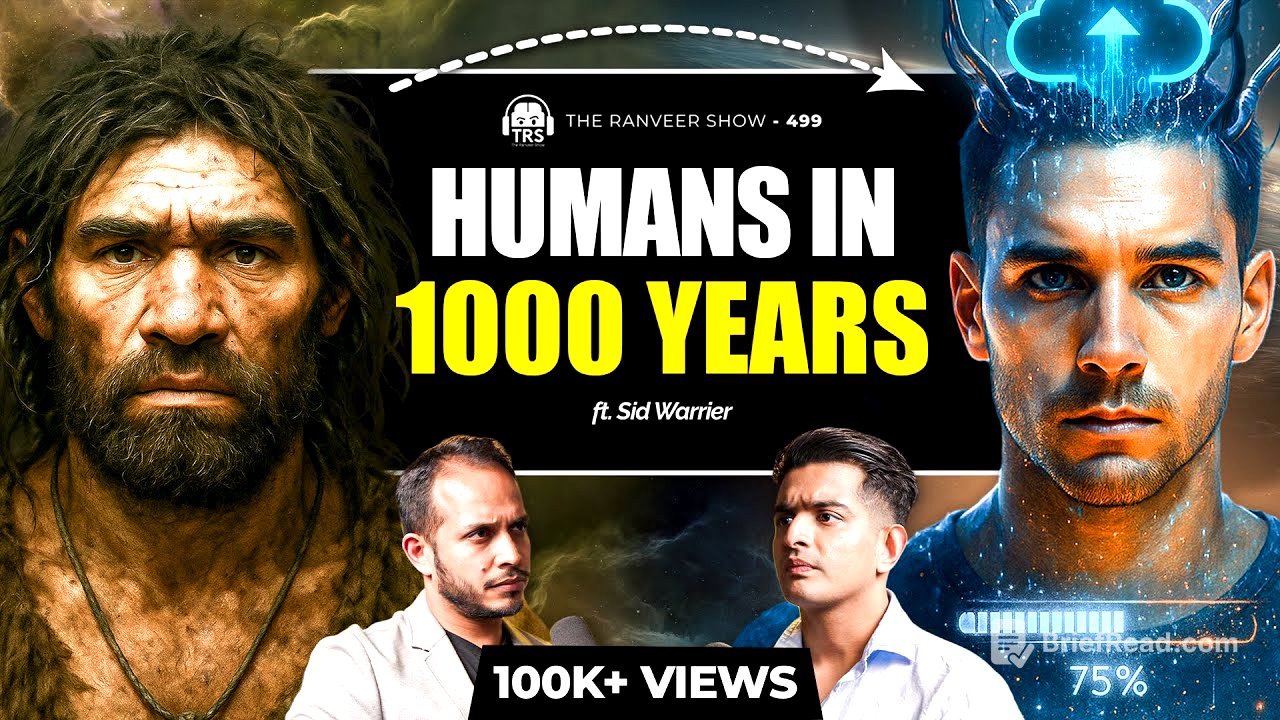TLDR;
This podcast episode explores the evolution of the human brain, starting from unicellular organisms to modern humans, and speculates on the future of human evolution. It covers neuroplasticity, the role of senses, the development of the brain, the significance of hands, and the concept of consciousness as a loop. The discussion also touches upon the impact of technology and societal changes on human evolution, and the importance of introspection and mental regulation.
- Evolution is driven by efficiency and control, not just survival.
- The brain developed to navigate complex environments, with the nervous system evolving for faster information transfer.
- Hands and face occupy 90% of brain real estate, highlighting their importance.
- Consciousness is a spectrum, not binary, involving a loop of self-awareness.
- Future evolution may involve incorporating AI and focusing on internal problem-solving.
Recap of Neuroplasticity and Intro to Evolution [2:38]
The discussion begins with a recap of neuroplasticity, which is the brain's ability to change neural connections, enabling learning and unlearning. The conversation then transitions to the evolution of the human species, particularly focusing on where the brain is headed next. The hosts aim to explore the timeline of evolution, starting from unicellular organisms, to understand the present and future stages of brain development.
From Unicellular Organisms to Nervous Systems [4:14]
The brain exists to navigate complex environments. Unicellular organisms, while lacking nervous systems, sense and react to their surroundings. These organisms began working together chemically, leading to multicellular organisms. Life is defined as organic matter capable of sensing, adapting, and reacting to the environment. Consciousness is viewed as a spectrum, evident in any entity capable of sensing and reacting. The development of nerves allowed for faster information transfer, crucial for survival.
Evolution of Neural Centers and the Spinal Cord [12:25]
As creatures grew, neural centers condensed into a single node for decision-making, leading to the development of the spinal cord. This development was driven by the need to hunt for food and gain energy. The nervous and gastric systems evolved in parallel, intricately connected. Survival, efficiency, and control are key drivers of evolution, pushing organisms to gain more control over their environment. The sense of smell and taste developed early, followed by pressure, sound, and finally, sight.
From Spinal Cord to Early Brain Development [19:21]
Earthworms, part of the bilateral species, have a nervous system and a GI system that developed together. As evolution progressed, movement became more efficient, requiring faster processing and a more efficient nervous system. The node at the end of the spinal cord grew bigger, leading to the development of the brain, with the front of the head housing the mouth and primary senses. The face has remained relatively unchanged throughout evolution, while the body below has undergone various experiments for efficient eating and survival.
Reptilian Brain and the Evolution of Mammals [27:44]
The reptilian brain, the most primitive part, is responsible for core survival functions like breathing, heart rate, and defense mechanisms. Reptiles have limited facial muscles and expressions. The shift from egg-bearing to mammals led to differences in brain evolution. The use of forelimbs for tasks other than walking led to the development of fingers, a significant step in brain development, enabling dexterity and manipulation of the environment.
Hands, Brain Real Estate, and the Chimpanzee Brain [37:32]
90% of the brain's real estate is dedicated to the face and hands, highlighting their importance. Chimpanzees also have hands, but human hands are more intricate. While chimpanzees can learn many things, humans possess metacognition, the ability to think about thinking. This self-awareness and introspection are unique to humans and require an evolved prefrontal cortex.
Consciousness, Hands, and the Future of Human Evolution [44:11]
Consciousness is a loop, with humans being conscious of being conscious. The role of hands may diminish as technology advances, with machines and AI taking over manual tasks. Eating remains the primary function, driven by the reptilian brain. The limbic brain introduces ego, while the prefrontal cortex enables planning and consideration of the future. Subjective time is explored, with the brain only aware of a portion of the time spent due to daydreaming and attention fluctuations.
Evolutionary Timeline and the Role of Empathy [55:05]
The discussion revisits the evolutionary timeline, highlighting the development of hands and the emergence of apes. The jump from chimpanzee to more advanced hominids may be linked to diet, such as eating fish rich in DHA. The biggest problem humans face is making the world a kinder place, which could be addressed by evolving the part of the brain responsible for empathy. Ego prevents empathy by creating a sense of danger and self-protection.
Degraded Food Quality, Lab-Made Meats, and Love [58:58]
The degraded quality of food affects our guts, and lab-made meats may reduce the need to kill animals for food. Love, often overlooked in evolution, is a combination of reproduction, emotion, and bonding. Romantic love involves adrenaline and dopamine, while bonding involves oxytocin. The word "love" encompasses multiple brain functions and evolutionary aspects.
Future Generations and the Impact of Technology [1:03:20]
Younger generations are more advanced due to access to information and technology, but they also face mental health challenges like anxiety. Overexposure to stimulation from iPads and social media can lead to attention issues. Protecting children from overstimulation is crucial. In the future, hair and toes may become obsolete, and metabolism and gut bacteria may change due to sedentary lifestyles and processed foods.
Science, AI, and the Prefrontal Cortex [1:11:03]
Science is advancing rapidly, with machines and AI becoming integrated into human biology. The newest parts of the prefrontal cortex are responsible for prediction and self-introspection. Prediction involves pattern recognition over time, while self-introspection involves thinking about emotions. Spirituality helps in understanding and regulating emotions, challenging the part of the brain at the brink of human evolution.
Ego Dissolution and the Expansion of Personal Space [1:18:01]
Successful people in the future will solve both external and internal problems. Introspection is a new skill, linked to spirituality. Ego dissolution involves diminishing the boundaries between the inner and external worlds. Personal space is fluid and can expand to include loved ones. Ego holds personal space in place, defining self and non-self. Hypothetically, love for everyone could expand personal space to encompass the world.
The Enigma of Enlightenment and the Looping of Consciousness [1:25:11]
The motivation of an enlightened person to engage with the world is questioned. Functional MRIs could reveal how their brains function without ego. Consciousness is a loop, with anything that loops upon itself becoming more conscious. Introspection is the ultimate looping, with meditation and self-reflection increasing consciousness. Long-term meditation calms the sympathetic system and improves stress management.









